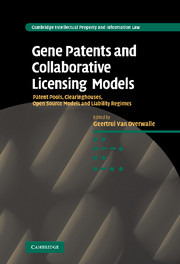 Gene Patents and Collaborative Licensing Models
Gene Patents and Collaborative Licensing Models Book contents
- Frontmatter
- Contents
- List of contributors
- Preface
- Foreword: Jean-Jacques Cassiman
- List of abbreviations
- Part I Patent pools
- Part II Clearinghouses
- Part III Open source models
- Part IV Liability regimes
- 17 Pathways across the valley of death. Novel intellectual property strategies for accelerated drug discovery
- 18 Case 10. The International Treaty on Plant Genetic Resources for Food and Agriculture (ITPGRFA). The Standard Material Transfer Agreement as implementation of a limited compensatory liability regime
- 19 Critical analysis: property rules, liability rules and molecular futures. Bargaining in the shadow of the cathedral
- Part V Different perspectives
- Part VI Summary and concluding analysis
- Index
- Titles in the series
17 - Pathways across the valley of death. Novel intellectual property strategies for accelerated drug discovery
from Part IV - Liability regimes
Published online by Cambridge University Press: 14 January 2010
- Frontmatter
- Contents
- List of contributors
- Preface
- Foreword: Jean-Jacques Cassiman
- List of abbreviations
- Part I Patent pools
- Part II Clearinghouses
- Part III Open source models
- Part IV Liability regimes
- 17 Pathways across the valley of death. Novel intellectual property strategies for accelerated drug discovery
- 18 Case 10. The International Treaty on Plant Genetic Resources for Food and Agriculture (ITPGRFA). The Standard Material Transfer Agreement as implementation of a limited compensatory liability regime
- 19 Critical analysis: property rules, liability rules and molecular futures. Bargaining in the shadow of the cathedral
- Part V Different perspectives
- Part VI Summary and concluding analysis
- Index
- Titles in the series
Summary
Introduction
Most therapeutic interventions produced by pharmaceutical firms take the form of small molecule drugs, which are mass produced at low marginal cost and ingested orally. Drug therapies typically work by affecting the activity of human proteins, known in the industry as targets, that have been implicated in disease pathways. Thus far, medical science has identified safe and effective therapies for only a few hundred of the estimated 3,000 protein targets in the human genome that are potentially susceptible to a drug. Moreover, pharmaceutical firms have encountered major obstacles in producing fundamentally new small molecule drugs, especially those that work against new targets. According to one report, an average of only three drugs that act on novel targets have reached the market annually in recent years.
This highly visible problem has attracted commentary in scholarly articles, government white papers and the popular press. Government agencies, such as the National Institutes of Health, and industry insiders, have also recognized that one of the most serious pitfalls involves the difficulty of moving across the so-called “valley of death” that separates upstream research on promising genes, proteins and biological pathways from downstream drug candidates. For example, an upstream finding that a given protein is differentially expressed in in dividuals with a particular disease may suggest that the protein merits further investigation.
- Type
- Chapter
- Information
- Gene Patents and Collaborative Licensing ModelsPatent Pools, Clearinghouses, Open Source Models and Liability Regimes, pp. 247 - 288Publisher: Cambridge University PressPrint publication year: 2009
- 4
- Cited by


